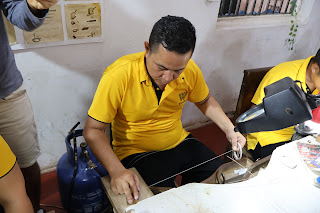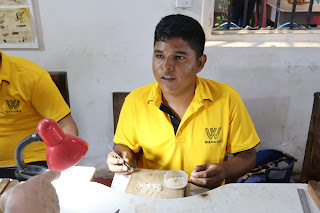Mompox, Colombia, is a town steeped in colonial charm and renowned for its
silver filigree craftsmanship, a tradition that has flourished for centuries
along the banks of the Magdalena River. This delicate art form involves
twisting ultra-fine silver threads into lace-like patterns, often inspired by
nature and geometry. The technique was introduced during the Spanish conquest,
when Iberian metalsmiths—many trained in Arab filigree methods—settled in
Mompox, drawn by its strategic location and abundance of precious metals.
The process begins with melting pure silver into ingots, which are then drawn
into wires as thin as a strand of hair. These wires are twisted, curled, and
soldered together using foot-pumped blowtorches and flux to create intricate
designs. Artisans often work with two types of wire: thicker ones for the
structural frame and ultra-fine ones for the decorative fill. Each piece is
assembled thread by thread, resulting in jewelry that is both lightweight and
visually rich, with patterns like caracol (snail), leaves, and birds
reflecting the region’s natural beauty.
Filigree in Mompox is more than a craft—it’s a family legacy. Workshops like
those run by the Tres Palacios family have passed down techniques through
generations, blending traditional motifs with modern interpretations. Each
artisan develops a distinct style, and many pieces are custom-made, tailored
to the client’s vision. The town’s cobbled streets echo with the rhythmic
tapping of hammers, a sound that speaks to the enduring vitality of this
heritage.
Today, Mompox filigree is celebrated worldwide for its elegance and
authenticity. Tourists flock to the town not only to purchase jewelry but to
witness the artistry firsthand. The rise in tourism has helped preserve the
tradition, with workshops offering demonstrations and even allowing visitors
to participate in the creation process. Whether it’s a shimmering pair of
earrings or a symbolic pendant, Mompox filigree carries the soul of a town
where time seems to stand still—and beauty is spun from silver.
|
Statue of Liberty in front of the cloister of San Carlos
|
|
Joyería Wamaris
Among the most celebrated workshops in
Mompox is Joyería Wamaris, a family-run business led by Doris Peñalosa,
who represents the third generation of filigree artisans in her family.
Wamaris stands out for its commitment to preserving traditional
techniques while embracing innovation in design. The process begins with
selecting high-quality silver or gold, which is then melted, drawn into
fine threads, and woven into patterns like zigzags, caracoles, and
ramales. These threads are soldered and shaped by hand, often taking
days to complete a single pair of earrings. The workshop also produces
custom pieces, including trays and decorative items, showcasing the
versatility of filigree beyond adornment.
-
What makes Wamaris particularly special is its dedication to community
and craftsmanship. The tools used in their workshop are locally made
by a skilled ironworker named José María, whose custom-forged
instruments are trusted by generations of artisans. This symbiotic
relationship between trades not only sustains the local economy but
also reinforces the authenticity of the craft. Wamaris has become a
beacon for aspiring jewelers in Mompox, offering mentorship and
employment to young artisans who wish to carry on the tradition.
-
Visiting Joyería Wamaris is more than a shopping experience—it's a
journey into the heart of Mompox’s cultural heritage. Guests can
witness the creation process firsthand, speak with the artisans, and
even participate in shaping a piece. Whether you're drawn to the
shimmering elegance of a filigree necklace or the story behind its
creation, Wamaris offers a tangible connection to the artistry and
spirit of this magical town.
|
|
Filigree Class
- Casting
- Forging
- Rolling
- Wire Drawing
- Forming and Reinforcement
- Fabrics
Souvenir
- Cut 4cm
- Notch 2cm
- Curved ends
- Bend and weld
- Filling
- Welding
- Polish and shine
|
|
Casting
Casting marks the fiery beginning of artisanal
silver filigree work, where raw silver is transformed into a usable
form.
-
This stage involves melting pure silver—often alloyed with small
amounts of copper for added strength—in a crucible heated to
temperatures exceeding 900°C.
-
Once liquefied, the molten metal is poured into a mold or channel to
form a bar or ingot.
-
This foundational step is critical: the quality and purity of the cast
metal directly influence the finesse and durability of the filigree
threads that will be drawn from it.
|
|
Lamination
After cooling, the silver bar undergoes
lamination, where it's hammered and passed through rolling mills to
reduce its thickness.
|
|
Wire drawing
The flattened bar is then pulled through
progressively smaller holes in a drawplate, producing ultra-fine
wires—sometimes as thin as 0.2mm.
|
|
Forming and Reinforcement
These wires are annealed (heated
and cooled) to soften them, making them pliable enough for the intricate
twists and curls that define filigree. Artisans must balance strength
and flexibility, ensuring the wire won’t snap during shaping but will
hold its form once set.
-
The drawn wire is often twisted into pairs or spirals, depending on
the desired pattern. This twisting adds both aesthetic texture and
structural integrity.
-
In traditional workshops, this is done manually using hand-cranked
drills or custom tools, with each artisan developing their own rhythm
and technique.
-
The twisted wire is then flattened or shaped further, ready to be
incorporated into the design.
-
This stage is where the metal begins to take on the personality of the
piece—whether it’s destined for a delicate pendant or an ornate tray.
|
|
Different silver filigree patterns: zig zag, winged, round snail,
goat's foot snail, branch and pandero
Silver filigree patterns are not just decorative motifs—they’re
the vocabulary of a centuries-old language spoken through twisted wire
and soldered dreams. Each pattern carries its own rhythm and symbolism,
shaped by regional traditions and the artisan’s hand.
-
The zigzag pattern, for instance, is one of the most fundamental. It’s
created by folding fine silver threads into sharp, angular waves,
often used to frame or fill larger designs. Its geometric precision
adds a sense of movement and structure, making it a versatile base in
both traditional and contemporary filigree.
-
The winged pattern evokes lightness and grace. Crafted by curving
paired wires outward like feathers or petals, it’s often used to
suggest flight, freedom, or divine protection. This motif appears
frequently in earrings and pendants, where its airy form complements
the delicate nature of filigree.
-
In contrast, the round snail and goat’s foot snail patterns are more
organic.
-
The round snail, or caramujo redondo, spirals inward like a
coiled shell, symbolizing eternity or introspection.
-
The goat’s foot snail (caramujo pata de cabra) adds a quirky
twist—its asymmetrical curl mimics the cloven shape of a hoof, lending
rustic charm and a touch of whimsy to the composition.
-
The branch pattern, or ramal, is inspired by nature’s fractal
beauty. It mimics the structure of twigs or vines, often branching out
from a central stem to create a sense of growth and vitality. This
pattern is especially popular in necklaces and brooches, where it can
be layered to create lush, botanical textures.
-
Finally, the pandero pattern—named after a traditional
tambourine—is circular and rhythmic, often used as a central motif. It
features concentric loops or scalloped edges that resemble the
instrument’s frame, and it’s typically surrounded by smaller patterns
to create a harmonious visual “beat.”
-
Together, these patterns form the expressive toolkit of filigree
artisans, each one contributing its own voice to the final piece.
Whether used in isolation or woven together, they reflect the
artisan’s mastery and the cultural heritage embedded in every twist of
silver.
|
|
Polish and shine
Once a silver filigree piece is complete,
its final polish is what elevates it from intricate craftsmanship to
radiant artistry. The goal is to enhance the natural luster of silver
while preserving the delicate wirework.
-
Artisans typically begin by cleaning the piece thoroughly to remove
any residues from soldering or handling. This may involve soaking it
in a mild detergent solution, brushing gently with a soft-bristled
brush, and rinsing with warm water. For stubborn tarnish, a soak in
lemon salt or a gentle silver cleaning solution can help restore
brightness without damaging the fine details.
-
The polishing itself is a careful dance between technique and
sensitivity. Because filigree is so intricate, traditional buffing
wheels can be too aggressive. Instead, jewelers often use soft chamois
buffs with polishing compounds like Zam or rouge, applied via a flex
shaft or hand tools. These materials are chosen for their ability to
reach into crevices without snagging or distorting the wirework. Some
artisans also use radial disks or mini muslin buffs to achieve a
mirror-like finish on the frame wires while leaving the inner filigree
slightly matte for contrast.
-
Once polished, the piece is dried and inspected under bright light to
ensure uniform shine and no residual tarnish. The final result is a
gleaming, lace-like creation that catches light from every angle. To
preserve this brilliance, owners are advised to store filigree jewelry
in soft cloth pouches or airtight containers, away from moisture and
chemicals. With proper care, the polish and shine of a silver filigree
piece can last for generations, embodying both the skill of the
artisan and the timeless elegance of the craft.
|
See Also
Source
Location
Mompox River Cruise
Minor Basilica of the Most Holy Christ of Mompox
Saint Barbara Church
Oratory of the Immaculate Conception

































